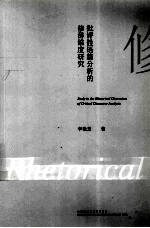

批评性语篇分析的修辞维度研究PDF电子书下载
- 电子书积分:9 积分如何计算积分?
- 作 者:李艳芳著
- 出 版 社:北京:外语教学与研究出版社
- 出版年份:2012
- ISBN:9787513511520
- 页数:198 页
Chapter 1 Introduction 1
1.1 Origin and Rationale for the Present Study 1
1.2 Objectives of the Present Study 7
1.3 Research Methodology 8
1.4 Organization of the Dissertation 9
Chapter 2 Literature Review 13
2.1 Intellectual Background for CDA 13
2.1.1 Linguistic Turn in Intellectual Climate 13
2.1.2 Rhetorical Turn in Discourse Studies 15
2.1.3 Critical Turn in the Study of Discourse 17
2.2 CDA:An Overview 18
2.2.1 Genesis of Critical Discourse Analysis 18
2.2.2 A Diverse Picture of Research on CDA abroad 21
2.2.3 Research on CDA at Home 23
2.2.4 Research on Metaphor in CDA 23
2.2.5 Critical Response to CDA 25
2.3 Introduction of the Rhetorical Perspective 28
2.3.1 Discourse Analysis and Rhetorical Criticism:Where They Converge and Diverge 30
2.3.2 Shared Focus between CDA and Critical Rhetoric 32
2.4 Summary 33
Chapter 3 Theoretical Preliminaries 34
3.1 Defining Key Concepts 34
3.1.1 Discourse 34
3.1.2 Power 37
3.1.3 Ideology 38
3.1.4 Being Critical 42
3.2 Ideology and the Social Construction of Meaning 43
3.2.1 The Critical Turn in the Study of Communication 43
3.2.2 Language as a Site of Social Struggle 45
3.2.3 Ideology as a Conceptual Link between Communication and Power 47
3.3 The Possibility of Rhetorical Intervention 51
3.4 Ideology,Symbolic Action and Agency 53
3.5 Summary 56
Chapter 4 Rhetoric,Power and Ideology 57
4.1 An Evolving Conception of Rhetoric 58
4.1.1 A Glimpse of Classical Rhetoric 58
4.1.2 An Overview of Rhetoric in Contemporary Times 60
4.1.3 Three Perspectives of Rhetorical Studies 61
4.2 Problematizing "Rhetoric as Epistemic" 62
4.3 From a Pragmatic View of Rhetoric to Rhetorical Materialism 64
4.3.1 A Turn in Rhetorical Paradigm 64
4.3.2 An Anatomy of Rhetorical Materialism 66
4.3.3 Comparing a Pragmatic Theory of Rhetoric and Rhetorical Materialism 68
4.4 A Running Theme in Rhetoric 69
4.4.1 The Self-effacement of Rhetoric 69
4.4.2 Rhetoric and Power 74
4.4.2.1 Rhetoric as Power Articulation 74
4.4.2.2 The Rhetorical Logic of Power 75
4.4.3 Rhetoric and Ideology 76
4.4.3.1 The Internal Modes of Operation of Ideology 76
4.4.3.2 Rhetoric as Carrier and Demystifier of Ideology 81
4.5 Etho as the Nexus between Rhetoric and CDA 84
4.5.1 Etho in Classical Rhetoric 84
4.5.2 Cambell's Theorizing of Etho 88
4.5.3 Postmodern Etho 90
4.6 Summary 91
Chapter 5 Deconstruction and Reconstruction:Kenneth Burke's Implication for CDA 93
5.1 Kenneth Burke and Rhetoric as Symbolic Action 94
5.1.1 A Synoptic View of Burke 94
5.1.2 Language as Metaphorical Selection 95
5.1.3 Terministic Screens as Constitutive of Rhetoric 100
5.2 Kenneth Burke's Dramatistic Pentad 102
5.2.1 The Power of Naming 102
5.2.2 Dramatism 103
5.2.3 The Paradoxical Term of Substance 108
5.3 A Rhetoric of Motives:Identification and Consubstantiality 110
5.4 The Burkean Framework:Deconstruction and Reconstruction 112
5.4.1 Kenneth Burke the Ideologist 112
5.4.2 Incorporation of Marx and Freud in the Rhetorical Framework 116
5.4.3 Reflection on Burkean New Rhetoric 117
5.5 Burke's Continued Relevance to Our Discussion of CDA 119
5.5.1 The Rhetoricality of CDA 119
5.5.2 Rhetorical Equipment for Living 120
5.6 Summary 123
Chapter 6 Metaphor as Terministic Screen 125
6.1 Three Perspectives on the Relationship between Metaphor and "Reality" 126
6.1.1 Description-oriented View of Metaphor 126
6.1.2 Constitution-oriented View of Metaphor 127
6.1.3 Deconstructive View of Metaphor 129
6.2 Metaphor through Rhetorical Lens 130
6.2.1 Metaphor as Formal Identification 130
6.2.2 Rhetorical Constitution of Metaphors 132
6.2.2.1 Metaphor as Naming 133
6.2.2.2 Metaphor as Enthymeme 136
6.2.2.3 Metaphors as Arguments 138
6.3 Ideological Dimensions of Metaphor 140
6.3.1 Metaphor,Ideology and Thought 140
6.3.2 Metaphor as a Central Strategy for Both Legitimisation and Delegitimisation 143
6.3.3 Metaphor as Evaluation 145
6.3.4 Metaphor and Myth 146
6.4 Summary 147
Chapter 7 Theoretical Model in Action 148
7.1 Metaphor Analysis 149
7.1.1 Case One:Reports on Columbia High School Shooting 149
7.1.2 Case Two:Key Metaphors Circulating in Post 9/11 Discourse 150
7.1.2.1 Introductory Remarks 150
7.1.2.2 The War Metaphor:How It Takes Shape in the President's Address 151
7.1.2.3 The Metaphorical Nature of "War" 154
7.1.2.4 War Metaphor as a "Double-Edged Sword" 156
7.1.2.5 Axis of Evil 157
7.1.2.6 War against Islamic Fascism 158
7.1.2.7 Summary 160
7.2 Pentad Analysis 162
7.2.1 Introductory Remarks 162
7.2.2 Analyzing the President's Speech with Dramatic Pentad 163
7.2.3 Hidden Ideology at Work 167
7.3 Summary 169
Chapter 8 Conclusions and Implications 171
8.1 Major Findings and Contributions 171
8.2 Pedagogical Implications 173
8.3 Limitations of the Research 174
8.4 Areas for Future Research 174
Appendix 176
Bibliography 185
- 《水面舰艇编队作战运筹分析》谭安胜著 2009
- 《分析化学》陈怀侠主编 2019
- 《影响葡萄和葡萄酒中酚类特征的因素分析》朱磊 2019
- 《仪器分析技术 第2版》曹国庆 2018
- 《全国普通高等中医药院校药学类专业十三五规划教材 第二轮规划教材 分析化学实验 第2版》池玉梅 2018
- 《Power BI数据清洗与可视化交互式分析》陈剑 2020
- 《行测资料分析》李永新主编 2019
- 《药物分析》贡济宇主编 2017
- 《土壤环境监测前沿分析测试方法研究》中国环境监测总站编著 2018
- 《药物分析》童珊珊,余江南 2019
- 《中风偏瘫 脑萎缩 痴呆 最新治疗原则与方法》孙作东著 2004
- 《水面舰艇编队作战运筹分析》谭安胜著 2009
- 《王蒙文集 新版 35 评点《红楼梦》 上》王蒙著 2020
- 《TED说话的力量 世界优秀演讲者的口才秘诀》(坦桑)阿卡什·P.卡里亚著 2019
- 《燕堂夜话》蒋忠和著 2019
- 《经久》静水边著 2019
- 《魔法销售台词》(美)埃尔默·惠勒著 2019
- 《微表情密码》(波)卡西亚·韦佐夫斯基,(波)帕特里克·韦佐夫斯基著 2019
- 《看书琐记与作文秘诀》鲁迅著 2019
- 《酒国》莫言著 2019
